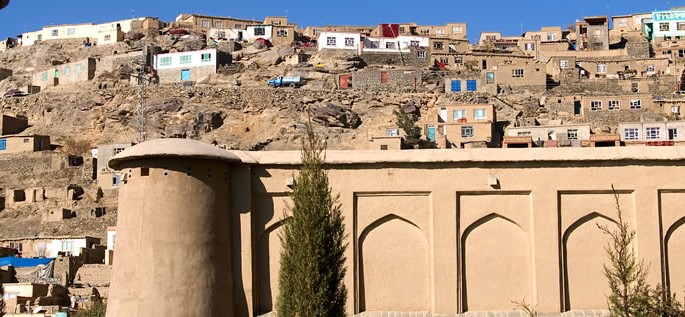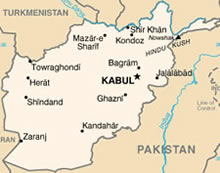
Pashto
Pashto, also known as Pakhto, Pashtu, and Pushto, is a member of the Indo-Iranian branch of the Indo-European language family. It spoken in Afghanistan, Pakistan, Kyrgyzstan, Tajikistan, and Pakistan as well as by a large diaspora encompassing India, Iran, United Arab Emirates, United Kingdom, and the United States. It may be spoken by around 50 million people worldwide (Ethnologue).
Status
 Afghanistan
Afghanistan
Southern Pashto is spoken by 6 million people in Afghanistan (Ethnologue). It is a co-official language of Afghanistan along with Dari (Eastern Persian). The relative status of Dari and Pashto are a sensitive topic in Afghan society. Although the Afghan constitution grants Dari and Pashto equal status, many Pashtuns feel that in reality their language is being discriminated against complaining that Dari is the dominant language in Afghan government, official proceedings, the judiciary, and in the print and electronic media, with up to 80% of all official communication being conducted in Dari. Primary and secondary education is available in both Dari and Pashto, as well as in some of Afghanistan’s other languages, and parents are free to choose the language of education for their children. However, most of instruction in Afghan universities is conducted in Dari. Moreoever, Dari serves as a de facto lingua franca among the various ethnic groups in the country.
Pakistan
Northern Pashto is spoken by 9.6 million people In Pakistan (Ethnologue), but it has no official status. It is taught in primary schools, but literacy rates are low. Pashtun children are educated in Urdu. Pashto is used in the print and electronic media.
Dialects
Pashto can be divided into dialect groups, differentiated mostly by pronunciation and some vocabulary. The major dialect divisions, in turn, have numerous variants. In general, however, speakers of Pashto dialects can understand each other. Lexical similarity between Northern and Southern Pashto is estimated at approximately 80% (Ethnologue).
| Northern Pashto | Eastern Afghan Pashto, Ningraharian Pashto, Northeastern Pashto, Northwestern Pashto. Northeastern Pashto has a number of subdialects such as Kohat, Yusufzai, Afridi, Shinwari, Mohmand, Shilmani. |
| Southern Pashto | Durani |
Structure
Sound system
The sound system of Pashto has many similarities to that of other Indo-Iranian languages. At the same time, Pashto stands out among them as having adopted certain features from neighboring Indo-Aryan languages, such as retroflex consonants.
Vowels
Pashto has the following vowel phonemes, i.e., sounds that differentiate word meaning. The inventory of vowels give below may vary somewhat from dialect to dialect. Pashto has a number of diphthongs, e.g., /ay, əy, āy, oy, uy, aw, āw/.
| Close |
i
|
. |
u
|
| Mid |
e
|
ə
|
o
|
| Open |
a – ā
|
- /ā/ = long /a/
- /ə/ = a in about
- In some dialects, the vowels /i/ and /u/ can be either short or long.
Consonants
Besides the consonants common to most modern Indo-Iranian languages, Pashto also has alveo-dental affricates /ts/, /dz/ and a set of retroflex consonants borrowed from neighboring languages of the Indian subcontinent. They are produced with the tongue curled back so that its underside touches the roof of the mouth. Also, unlike other Indo-Iranian languages, Pashto allows consonant clusters at the beginning of syllables, e.g., xpa ‘foot’, nwar ‘sun’.
The chart below shows the consonant inventory of Pashto as reflected in the Kandahar dialect of Southern Pashto, but does not cover all the existing dialectal variations. In addition, there are some consonants in Pashto that do not occur in the speech of monolingual speakers, but only in the formal speech of bilingual educated people who speak both Pashto and Dari. In the table below, they are given in parentheses.
| Retroflex | Uvular | ||||||||
|---|---|---|---|---|---|---|---|---|---|
| Stops | voiceless |
t
|
ʈ
|
(q)
|
ʔ
|
||||
| voiced |
ɖ
|
g
|
|||||||
| Fricatives | voiceless |
(f)
|
ʂ
|
ʃ
|
x
|
(h)
|
|||
| voiced |
z
|
ʐ
|
ʒ
|
ɣ
|
|||||
| Affricates | voiceless |
ts
|
tʃ
|
||||||
| voiced |
dz
|
dʒ
|
|||||||
| Nasals |
n.
|
ɳ
|
|||||||
| Laterals | |||||||||
| Rhotic |
ɽ
|
||||||||
| Approximants |
- There is a contrast between and apical vs. retroflex consonants, e.g., /t/ – /ʈ/, /d/ – /ɖ/, /s/ – /ʂ/, /z/ – /ʐ/ , /n/ – /ɳ/, /r/ – /ɽ/. Apical consonants are produced with the tip of the tongue touching the roof of the mouth, whereas retroflex consonants are produced with the tongue curled, so that its underside comes in contact with the roof of the mouth.
- /q/ has no equivalent in English
- /ʔ/ = sound between vowels in uh-oh
- /ʃ/ = sh in shop
- /tʃ/ = ch in chop
- /ʒ/ = s in pleasure
- /dʒ/ = j in job
- /ɣ/ has no equivalent in English
- /j/ = y in yet
Stress
Stress can fall on any syllable of a word. It can distinguish the meaning of otherwise identical words, e.g., áspa ‘mare’ and aspá ‘spotted fever’.
Grammar
Pashto is a highly inflected language with a complex system of noun declensions and verb conjugations.
Nouns, adjectives, and pronouns
Pashto nouns, adjectives, and pronouns are marked for the following categories:
- two genders: masculine and feminine
- two numbers: singular and plural, with a variety of plural markers
- three cases: direct, oblique, and vocative (only in the singular). Cases are marked with prefixes, suffixes or both. Direct case is used for both subjects and objects.
- There are no articles.
- There are three declensions for nouns, and five for adjectives.
- There are first- and second-persons pronouns. Third person is represented by proximate and remote demonstrative pronouns (similar to ‘this’ and ‘yonder’)
- All modifiers agree with the nouns they modify in gender, number, and case.
Verbs
Verbs agree with their subjects in person, number and gender. Below are some features of Pashto verbs:
- Verbs have two stems: present and past.
- Present stems can be simple or secondary.
- Simple tenses are formed by the addition of personal endings to the two stems.
- Secondary stems consist of a root + suffixes that indicate transitivity, intransitivity, and causativity.
- There are three tenses: present, past, and future.
- There are two voices: active and passive.
- There are two aspects: imperfective and perfective. Aspect is as important as tense.
- There are four moods: indicative, conditional, imperative, and potential.
- Past tense transitive sentences are formed as ergative constructions, i.e., transitive verbs in the past tense agree with the object, rather than the subject of the sentence.
Word order
The normal word order in Pashto is Subject-Object-Verb. All modifiers precede the nouns they modify
Vocabulary
Pashto shares most of its vocabulary with other Indo-Iranian languages. It has also borrowed words from other languages. For instance, Pashto spoken in Pakistan contains a great many loanwords from Urdu. Due to the influence of Islam, Pashto has also borrowed many words from Arabic. Some of the oldest borrowings from Greek date back to the 3rd-century BC Greek occupation of the territory that is now Afghanistan. Pashto has also borrowed words from neighboring Indo-Aryan languages. Today, the most important source of borrowing is English, particularly in the areas of science, technology, politics, and the military.
Below are a few basic sentences and words in Pashto in romanization.
| Hello | As salam ‘alaykum |
| Good-bye | Khuda hafiz |
| Please | Meharbani |
| Thank you | Deyra manana |
| Excuse me | Bakhana ghwaarom |
| Yes | Ho |
| No | Na |
| Man | Saray |
Below are Pashto numerals 0-10 in romanization.
|
0
|
1
|
2
|
3
|
4
|
5
|
6
|
7
|
8
|
9
|
10
|
|---|---|---|---|---|---|---|---|---|---|---|
|
sifer
|
yaw
|
dwa
|
dre
|
chalor
|
pinja
|
shpazh
|
oova
|
ata
|
nah
|
llas
|
Writing
The first written records of Pashto date back to the 16th century. Pashto has always been written with a modified Perso-Arabic script that contains additional letters to represent consonants specific to Pashto. Until the spelling system was standardized in the late 18th century, the representation of these consonants varied greatly. With the adoption of Pashto as a national language of Afghanistan in 1936, the writing system underwent some additional modifications that resulted in greater consistency. Various transliteration systems used today for representing Pashto with Latin letters lack standardization and may be confusing.
The Pashto alphabet used to write all varieties of the languages today has 44 letters. It uses all 28 letters of the Arabic alphabet, and shares 3 letters with Persian and Urdu. Since Pashto has more vowels than Arabic and Persian, it has more letters representing vowel sounds than contained in the Perso-Arabic script.
Pashto has an extensive literary tradition. Pashtun folk literature includes stories set to music, and a large number of short poems, traditionally composed by women, reflecting their daily lives.
Below is Article 1 of the Universal Declaration of Human Rights in Pashto script and romanization.
Difficulty
 How difficult is it to learn Pashto?
How difficult is it to learn Pashto?Pashto is considered to be a Category IV language on the Defense Language Institute scale in terms of difficulty for speakers of English.
 Afghanistan
Afghanistan